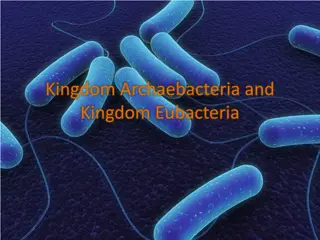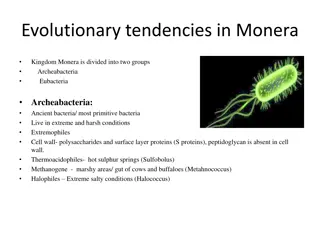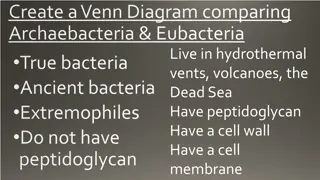Understanding Archaebacteria: A Brief Overview
Archaebacteria are a unique group of single-celled organisms that thrive in extreme and normal environments. Discovered in the 1970s, they have distinct cell structures and lack peptidoglycan in their cell walls. This article explores the basic facts, structure, and cell envelopes of Archaebacteria, shedding light on their classification and characteristics.
Download Presentation

Please find below an Image/Link to download the presentation.
The content on the website is provided AS IS for your information and personal use only. It may not be sold, licensed, or shared on other websites without obtaining consent from the author. Download presentation by click this link. If you encounter any issues during the download, it is possible that the publisher has removed the file from their server.
E N D
Presentation Transcript
ARCHAEBACTERIA V. SREENIVASULA REDDY
INTRODUCTION Biologists have long organized living things into six large groups called kingdoms. There are: Archaebacteria Eubacteria Protista Fungi Plantae Animalia
In 1996, scientists decided to split into two groups of bacteria: Archaebacteria and Eubacteria Because these two groups of bacteria were different in many ways scientists created a new level of classification called a DOMAIN. Now we have 3 domains 1.Bacteria 2. Archaea 3. Eukarya
New branch of life.... In 1970s carl woese proposed -3 domain classification
BASIC FACTS ABOUT ARCHAEA They live in extreme environments (like hot springs or salty lakes) and normal environments (like soil and ocean water). All are unicellular (each individual is only one cell). No peptidoglycan in their cell wall. Some have a flagella that aids in their locomotion.
STRUCTURE Size: Archaea are slightly less than 1 micron long. A micron is 1/1,000 of a millimeter. In order to see their cellular features, scientists use powerful electron microscopes. Shape: Shapes can be spherical or ball shaped and are called coccus. Others are rod shaped, long and thin, and labeled bacillus. Variations of cells have been discovered in square and triangular shapes.
Archaeal cell envelopes One of he distinctive feature ofthe archaea is the nature of envelope S-layer is the major component ofthe cellwall Some archaea lacks cellwall but have a glyocalyx lying out side the cell membrane Capsules and slime layers are rareamong archaea
CELL WALL Archael cellwall lacks peptidoglycan and exhibit considerable variety in terms of their chemical make up The most common type of archaeal cell wall is an S-layer composed of either protein or glycoprotein The layer may be as thick as 20 to 40 nm. eg; methanococcus, halobacterium Other archaea have additional layers of material outside the S-layer Methanospirillum has a protein sheath external to the s-layer Methanosarcina has a layer of chondroitin- like material, this material is called methanochondroitin
In some archaea S-layer is the outer most layer and separated from the plasma membrane by pseudomurein pseudomurein is a peptidoglycan-like molecule. Differs from peptidoglycan in that it has N- acetyltalosaminuronic acid and beta (1,3) glycosidic linkage instead of N- acetylmuramic acid and beta (1,4) glycosidic linkage. eg- Methanobacterium, Methanothermus and Methanopyrus The last type of archaeal cell wall does not include an s-layer .these archaea have a wall with a single, homogenous layer resembling in gram- positive bacteria
ARCHAEAL PLASMA MEMBRANES Archaeal membranes are composed primely of lipids that differ from bacterial and eukaryotic in two ways. They contain hydrocarbons derived from isoprene units(five carbon, branched) Hydrocarbons attached to glycerol by ether linkage rather than ester links This ether bonding makes it possible for archaea to survive in environments that are extremely acidic or alkaline, or that have great extremes in temperature. 1. 2.
GENETICS & MOLECULAR BIOLOGY Genomes are significantly smaller than bacteria. E. coli 2.5 x 109Daltons T. acidophilum 0.8 x 109Daltons Methanosarcina acetivorans,the largest known archaeal genome. Nanoarchaeum equitans, the smallest archaeal genome known. Plasmids are also found. Archaea usually have a single circular chromosome.
Transcription and translation in archaea resemble these processes in eukaryotes more than in bacteria Archaea have a single type of RNA Polymerase and similar to eukaryotes Aarchaeal genes lack introns Hyperthermophiles posses reverse DNA gyrase.
NUTRITIONAL TYPES IN ARCHAEA Nutritional type Source of energy Source of carbon Examples Organic compounds Phototrophs Sunlight Halobacteria Organic compounds or carbon fixation Ferroglobus, Methanobacteria or Pyrolobus Inorganic compounds Lithotrophs Organic compounds or carbon fixation Pyrococcus, Sulfolobus or Methanosarcinales Organic compounds Organotrophs
COMPARISON BETWEEN ARCHEAEA AND EUBACTERIA
S.No Character Cell type Cell Morphology Habitat Eubacteria Prokaryotic Variable Present every where Archeabacteria 1. 2. Prokaryotic Variable Mostly initiated in extreme environmental condition. Variety of types, no muramic acid Ether linked branched aliphatic chains are present containing D- glycerol phosphate 1,3 linkages Complex subunit pattern similar to eukaryotic enzyme 3. Cell Wall Peptidoglycan with muramic acid Ester linked, straight- chained fatty acids are present containing l-glycerol phosphate 4. Membrane lipids 5. Glycosidic linkages DNA Dependent RNA polymerase 1,4 linkages Simple subunit pattern 6. 7. No thymine in T C arm of tRNA tRNA Thymine present in most tRNAs 8. 9. 10. Intron Introns are absent Circular Introns are present Circular Chromosome
S.No Character Eubacteria Archeabacteria 11. Replication origins Single Multiple 12. RNA polymerase Single Multiple 13. Initiator tRNA Formyl-methionine Methionine 14. Streptomycin inhibition Sensitive Resistant
ARCHAEA CLASSIFICATION Members of the domain Archaea are phylogenetically divided into four kingdoms. Phylogeny of domain Archaea based on comparison of the 16S rRNA sequences. 1. Euryarchaeotoa 2. Crenarchaeota 3. Nanoarcheota 4. Korarchaeota
Phylum Representative organisms Representative micrograph Euarcheaeotes Methanogens: Methane production causes flatulence in humans and other animals. Halobacteria: Large blooms of this salt- loving archaea appear reddish due to the presence of bacteriorhodopsin in the membrane. Bacteriorhodopsin is related to the retinal pigment rhodopsin. This methanogens, methane as a metabolic waste product, and halobacteria, which live in an extreme environment. phylum includes produce which saline Halobacterium strain NRC-1 Sulfolobus: Members of this genus grow in volcanic springs at temperatures between 75 and 80 C and at a pH between 2 and 3. Crenarchaeota Members phylum play an important role in the fixation of carbon. of this ubiquitous Many members of this group are sulfur-dependent extremophiles. being infected by Sulfolobus bacteriophage Some hyperthermophilic. are thermophilic or
Phylum Representative organisms Representative micrograph Nanoarchaeum equitans: This species was isolated from the bottom of the Atlantic Ocean hydrothermal vent at Yellowstone National Park. It is an obligate symbiont with Ignicoccus, another species of archaea. Nanoarchaeota and from a This group currently contains only one species: equitans. Nanoarchaeum Nanoarchaeum equitans (small dark spheres) are in contact host, Ignococcus with their larger Korarchaeota This group is considered to be one of the most primitive forms of life. Members of this phylum have only been found in the Obsidian Pool, a hot spring at Yellowstone National Park. No members of this species have been cultivated. This image shows a variety of korarchaeota species from the Yellowstone National Park. Obsidian Pool at
SIGNIFICANCE OF ARCHAEA Methanogens are used for the production of methane which is a rich source of energy (bio gas) Methanogenic archaea are a vital part of sewage treatment. Halophilic archaea are used to prescreen antitumor drugs active on eukaryotic proteins. Thermophilic archaea are used in PCR. Thermostable DNA polymerases, such as the Pfu DNA polymerase from Pyrococcus furiosus Amylases, galactosidases and pullulanases in other species of Pyrococcus that function at over 100 C (212 F) allow food processing at high temperatures such as the production of lactose milk and whey. In mineral processing, acidophilic archaea display promise for the extraction of metals from ores, including gold, cobalt and copper.
Thank You References: https://www.slideshare.net/arijabuhaniyeh/chapter-3-microbiology-8th-edition?from_action=save ttps://www.slideshare.net/geogeorgegg/archea https://www.slideshare.net/khushbo0/archeabacteria-presentation https://biologydictionary.net/archaebacteria/























